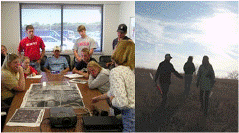Environmental and Sustainability Studies Program

Department of Environmental Studies: Undergraduate Student Theses
Date of this Version
Spring 5-2019
Document Type
Thesis
Abstract
One of the biggest challenges with the American food system is that 30-40% of our food is wasted every year (EPA, 2018). There are many reasons why food is being wasted around Universities campuses, and there are many ways to divert that wasted material from the landfill. In 2016, a zero-food waste event was held in Harper dining hall, and they found around 70 pounds a night just from a dinner rush. The main objective is aimed to find out how the University of Nebraska Lincoln (UNL) handles their dining hall food waste. This study will look at what Big TEN Universities do with their food waste. The main question is what are the best option(s) for universities that handle dining hall food waste on a large scale. The Universities will be viewed through the lens of the Food Recovery Hierarchy, which contains the most preferred method of source reduction, donating to non-profits, feed the animals, industrial uses, composting and least preferred landfill/incineration (see image, page 8).
This study will be done using a systematic approach, meaning it will be set up so it can be replicated easily. Specifically, will focus on Universities’ ideas and practices regarding dining hall food waste. In addition, to the research on each Big TEN University, a survey will be sent to the Universities’ dining hall management, as well as interviews with some of the cooks in UNL’s dining halls. The results show that most of the Big TEN Universities reuse their food waste by reducing first, then donating, composting or anaerobic digestors. The surveys show that these Universities are highly aware of the issue, and spend lots of money and time to reduce their footprint. As for UNL, they compare well to other Universities, and they have the resources to handle dining hall food waste on a larger scale. What UNL could do is to track their food waste to get an idea of quantity, and create basic infrastructure and supplies to compost. In addition, they could Increase donation when possible, and think about anaerobic digestors options off campus that will digest the food waste for fertilizer.
Included in
Environmental Education Commons, Natural Resources and Conservation Commons, Sustainability Commons

